fistree
Network of connected fuzzy inference systems
Description
Use a fistree object to represent a tree of interconnected fuzzy
inference systems.
Creation
Description
fisTree = fistree(fis,connections)
fisTree = fistree(___,Name=Value)
Input Arguments
This property is read-only.
Fuzzy inference systems, specified as an array of FIS objects. You can specify any
combination of mamfis, sugfis,
mamfistype2,
and sugfistype2
objects. Each fuzzy inference system in the fis array must have
at least one input and one output for fistree construction. To
evaluate a fistree, each fuzzy inference system must have at
least one rule.
This argument sets the FIS property.
Connections between fuzzy inference systems, specified as a two-column string array. Each row represents a connection between two FIS objects. You can specify two types of connections.
Output-to-input connections — Specify a connection from the output of one FIS to the input of a different FIS.
Input-to-input connections — Specify a connection between two inputs so that they use the same input value.
To define a connection, specify the FIS name and variable name for both the source
a destination of the connection. For example, ["fisFrom/out1"
"fisTo/in1"] defines a connection from output out1 of
FIS fisFrom to input in1 of FIS
fisTo.
The following figure demonstrates the different connection types using three FIS
objects, fis1, fis2, and
fis3.

This FIS tree includes the following connections.
["fis1/output1" "fis3/input1"]— Connection from outputoutput1offis1to inputinput1offis3["fis2/output1" "fis3/input2"]— Connection from outputoutput1offis2to inputinput2offis3["fis1/input2" "fis2/input1"]— Connection from inputinput2offis1to inputinput1offis2
Connections must satisfy the following conditions:
A
fistreeobject must have at least one FIS input without any incoming connection and one FIS output without any outgoing connection.A FIS input cannot have more than one incoming connection.
A FIS output can have more than one outgoing connection.
An input and output of the same FIS cannot be connected. In other words, you cannot create loops between connected FIS objects.
Symmetric connections between two inputs are not supported, For example,
["fis1/a" "fis2/b";"fis2/b" "fis1/a"]is not supported. Instead, specify["fis1/a" "fis2/b"]or["fis2/b" "fis1/a"].Self-input loops, such as
["fis1/a" "fis1/a"], are not supported.
This argument sets the Connections property.
Name-Value Arguments
Specify optional pairs of arguments as
Name1=Value1,...,NameN=ValueN, where Name is
the argument name and Value is the corresponding value.
Name-value arguments must appear after other arguments, but the order of the
pairs does not matter.
Example: Name="mytree" sets the FIS tree name to
"mytree"
Since R2021b
FIS tree name, specified as a string or character vector.
This argument sets the Name property.
Option for disabling structural checks when the FIS tree is updated after initial FIS creation, specified as one of the following values.
false— Automatically update connections, inputs, and outputs. This option ensures that the FIS tree is always valid and can be evaluated.true— Do not automatically update connections, inputs, and outputs. In this case, the resulting FIS tree can be in an invalid state, which can cause an error during evaluation.
Enable this option to improve computational efficiency when you programmatically construct a FIS tree.
This argument sets the DisableStructuralChecks
property.
Properties
Since R2021b
FIS tree name, specified as a string or character vector.
This property is read-only.
Fuzzy inference systems, specified as an array of FIS objects. You can specify any
combination of mamfis, sugfis, mamfistype2, and
sugfistype2
objects. Each fuzzy inference system in the fis array must have at
least one input and one output for fistree construction. To
evaluate a fistree, each fuzzy inference system must have at least
one rule.
Connections between fuzzy inference systems, specified as a two-column string array. Each row represents a connection between two FIS objects. You can specify two types of connections.
Output-to-input connections — Specify a connection from the output of one FIS to the input of a different FIS.
Input-to-input connections — Specify a connection between two inputs so that they use the same input value.
To define a connection, specify the FIS name and variable name for both the source a
destination of the connection. For example, ["fisFrom/out1"
"fisTo/in1"] defines a connection from output out1 of FIS
fisFrom to input in1 of FIS
fisTo.
The following figure demonstrates the different connection types using three FIS
objects, fis1, fis2, and
fis3.

This FIS tree includes the following connections.
["fis1/output1" "fis3/input1"]— Connection from outputoutput1offis1to inputinput1offis3["fis2/output1" "fis3/input2"]— Connection from outputoutput1offis2to inputinput2offis3["fis1/input2" "fis2/input1"]— Connection from inputinput2offis1to inputinput1offis2
Connections must satisfy the following conditions:
A
fistreeobject must have at least one FIS input without any incoming connection and one FIS output without any outgoing connection.A FIS input cannot have more than one incoming connection.
A FIS output can have more than one outgoing connection.
An input and output of the same FIS cannot be connected. In other words, you cannot create loops between connected FIS objects.
Symmetric connections between two inputs are not supported, For example,
["fis1/a" "fis2/b";"fis2/b" "fis1/a"]is not supported. Instead, specify["fis1/a" "fis2/b"]or["fis2/b" "fis1/a"].Self-input loops, such as
["fis1/a" "fis1/a"], are not supported.
This property is read-only.
Inputs to the FIS tree, specified as an array of strings. Inputs are automatically
determined using the specified connections of the fistree object.
FIS inputs with no incoming connections are included in
Inputs.
Update this property by updating the connections of the fistree
object.
Outputs of the FIS tree, specified as a string array. Outputs are automatically
determined using the specified connections of the fistree object.
FIS outputs without any outgoing connections are included in
Outputs.
You can update this property after initial construction of the
fistree object. You can remove an existing input or add
additional intermediate outputs. Outputs must contain at least one
output.
Option for disabling structural checks when the FIS tree is updated after initial FIS creation, specified as one of the following values.
false— Automatically update connections, inputs, and outputs. This option ensures that the FIS tree is always valid and can be evaluated.true— Do not automatically update connections, inputs, and outputs. In this case, the resulting FIS tree can be in an invalid state, which can cause an error during evaluation.
Enable this option to improve computational efficiency when you programmatically construct a FIS tree.
Object Functions
evalfis | Evaluate fuzzy inference system |
plotfis | Display fuzzy inference system |
getTunableSettings | Obtain tunable settings from fuzzy inference system |
getTunableValues | Obtain values of tunable parameters from fuzzy inference system |
setTunableValues | Specify tunable parameter values of a fuzzy inference system |
Examples
Create a Mamdani fuzzy inference system and a Sugeno fuzzy inference system.
fis1 = mamfis(Name="fis1",NumInputs=2,NumOutputs=1); fis2 = sugfis(Name="fis2",NumInputs=2,NumOutputs=1);
Define a connection from the output of fis1 to the first input of fis2.
con1 = ["fis1/output1" "fis2/input1"];
Create a FIS tree using the fuzzy inference systems and connection.
tree = fistree([fis1 fis2],con1);
Visualize the tree.
plotfis(tree)
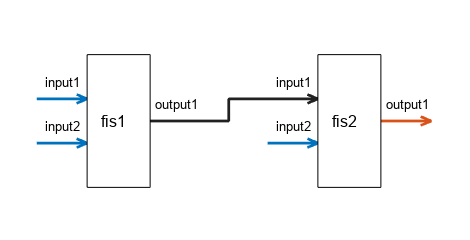
Create a tree with two FISs and no connections.
fis1 = mamfis(Name="fis1",NumInputs=2,NumOutputs=1); fis2 = mamfis(Name="fis2",NumInputs=2,NumOutputs=1); fisT = fistree([fis1 fis2],[]);
Display the FIS tree configuration.
plotfis(fisT)

You can add a FIS to a FIS tree by appending a FIS object to the FIS property of the tree.
Add fis3 to the FIS tree.
fis3 = mamfis(Name="fis3",NumInputs=2,NumOutputs=1);
fisT.FIS(end+1) = fis3;Connect the outputs of fis1 and fis2 to the inputs of fis3.
fisT.Connections = [
"fis1/output1" "fis3/input1";
"fis2/output1" "fis3/input2"];Display the updated FIS tree configuration.
plotfis(fisT)
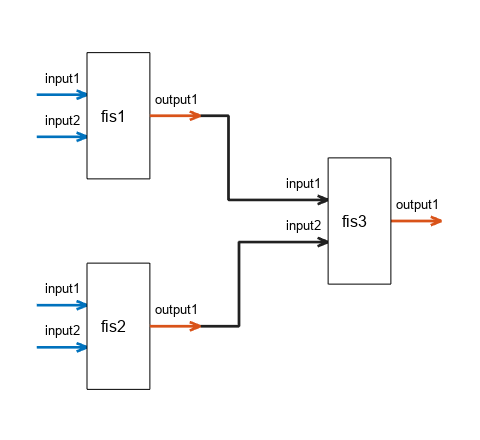
Remove the first FIS (fis1) from the FIS tree.
fisT.FIS(1) = [];
Display the updated FIS tree configuration.
plotfis(fisT)
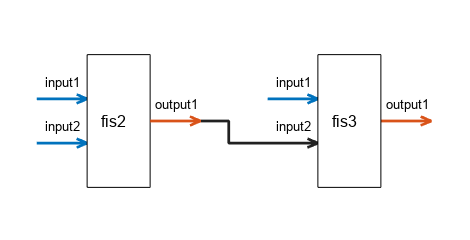
The corresponding connection to the first input of fis3 is also removed.
Create fis1, fis2, and fis3, each with two inputs and one output.
fis1 = mamfis(Name="fis1",NumInputs=2,NumOutputs=1); fis2 = mamfis(Name="fis2",NumInputs=2,NumOutputs=1); fis3 = mamfis(Name="fis3",NumInputs=2,NumOutputs=1);
Create a connection between output 1 of fis1 and input 1 of fis3.
con1 = ["fis1/output1" "fis3/input1"];
Create a connection between output 1 of fis2 and input 2 of fis3.
con2 = ["fis2/output1" "fis3/input2"];
Create a connection between input 2 of fis1 and input 1 of fis2.
con3 = ["fis1/input2" "fis2/input1"];
Create and display the FIS tree.
fuzzTree = fistree([fis1 fis2 fis3],[con1;con2;con3]); plotfis(fuzzTree)
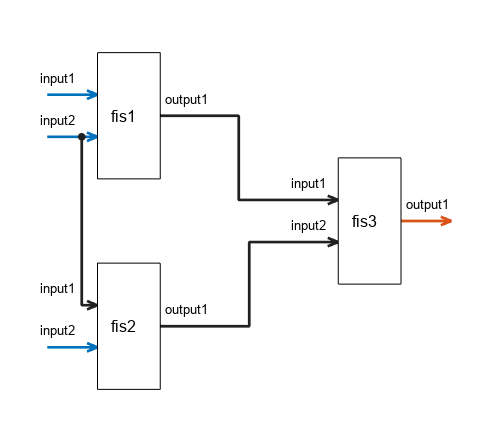
Display the inputs of the FIS tree. These inputs correspond to all free inputs that do not have an incoming connection.
fuzzTree.Inputs
ans = 3×1 string
"fis1/input1"
"fis1/input2"
"fis2/input2"
Evaluate the fuzzy tree. Specify values for input 1 of fis1, input 2 of fis1, and input 2 of fis2. The value for input 2 of fis1 is also applied to input 1 of fis2.
output = evalfis(fuzzTree,[0.8 0.25 0.7]);
Create two FIS objects, each with two inputs and one output.
fis1 = mamfis(Name="fis1",NumInputs=2,NumOutputs=1); fis2 = mamfis(Name="fis2",NumInputs=2,NumOutputs=1);
Connect the output of fis1 to the second input of fis2.
con = ["fis1/output1" "fis2/input2"];
Create the FIS tree.
fuzzTree = fistree([fis1 fis2],con);
Display outputs of the FIS tree. By default, the open FIS output from fis2 is an output of the FIS tree.
fuzzTree.Outputs
ans = "fis2/output1"
Visualize the FIS tree.
plotfis(fuzzTree,Legend="on")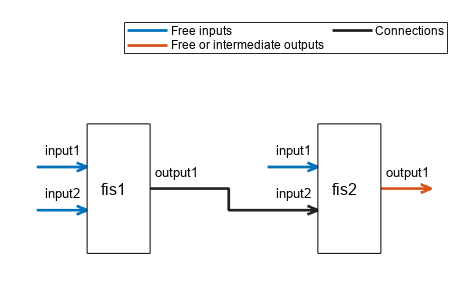
Add the output of fis1 to the list of outputs.
fuzzTree.Outputs(end+1) = "fis1/output1";Display the updated output list of the FIS tree.
fuzzTree.Outputs
ans = 2×1 string
"fis2/output1"
"fis1/output1"
Visualize the FIS tree. The added intermediate output is highlighted.
plotfis(fuzzTree,Legend="on")
Evaluate the FIS tree. The result contains the outputs from fis2 and fis1.
evalfis(fuzzTree,[0.5 0.2 0.8])
ans = 1×2
0.1579 0.1579
Remove the first output from the list.
fuzzTree.Outputs(1) = [];
Display the updated output list of the FIS tree.
fuzzTree.Outputs
ans = "fis1/output1"
Visualize the FIS tree without the removed output. The visualization indicates that the output of fis2 is unused.
plotfis(fuzzTree,Legend="on")
Evaluate the FIS tree again. The result now contains the output of only fis2.
evalfis(fuzzTree,[0.5 0.2 0.8])
ans = 0.1579
This example shows the construction of an incremental FIS tree. For more information on the types of fuzzy tree structures, see FIS Trees.
Create fuzzy systems fis1, fis2, and fis3, each with two inputs and one output.
fis1 = mamfis(Name='fis1',NumInputs=2,NumOutputs=1); fis1.Inputs(1).Name = "color"; fis1.Inputs(2).Name = "doors"; fis2 = mamfis(Name='fis2',NumInputs=2,NumOutputs=1); fis2.Inputs(2).Name = "power"; fis3 = mamfis(Name='fis3',NumInputs=2,NumOutputs=1); fis3.Inputs(2).Name = "autopilot"; fis3.Outputs(1).Name = "prediction";
Create a connection between output 1 of fis1 and input 1 of fis2.
con1 = ["fis1/output1" "fis2/input1"];
Create a connection between output 1 of fis2 and input 1 of fis3.
con2 = ["fis2/output1" "fis3/input1"];
Create the FIS tree.
incTree = fistree([fis1 fis2 fis3],[con1;con2]);
Visualize the tree structure. At each level of the tree structure, an additional input is combined with the output of the previous level.
plotfis(incTree)

This example shows the construction of an aggregated FIS tree. For more information on the types of fuzzy tree structures, see FIS Trees.
Create fuzzy systems fis1, fis2, and fis3, each with two inputs and one output.
fis1 = mamfis('Name','fis1',NumInputs=2,NumOutputs=1); fis1.Inputs(1).Name = "dist_obs"; fis1.Inputs(2).Name = "angle_obs"; fis2 = mamfis('Name','fis2',NumInputs=2,NumOutputs=1); fis2.Inputs(1).Name = "dist_tar"; fis2.Inputs(2).Name = "angle_tar"; fis3 = mamfis('Name','fis3',NumInputs=2,NumOutputs=1); fis3.Outputs(1).Name = "heading_robot";
Create a connection between output 1 of fis1 and input 1 of fis3.
con1 = ["fis1/output1" "fis3/input1"];
Create a connection between output 1 of fis2 and input 2 of fis3.
con2 = ["fis2/output1" "fis3/input2"];
Create the FIS tree.
aggTree = fistree([fis1 fis2 fis3],[con1;con2]);
Visualize the tree structure.
plotfis(aggTree)
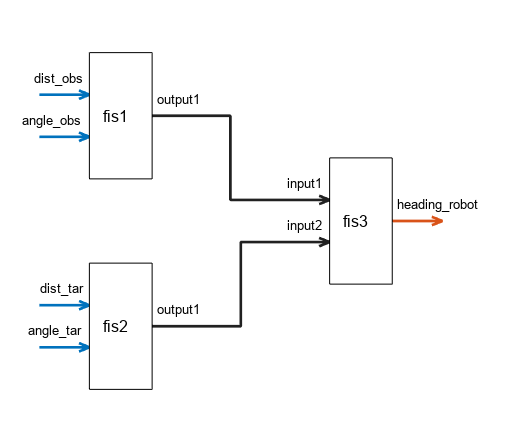
This example shows the construction of a cascaded FIS tree. For more information on the types of fuzzy tree structures, see FIS Trees.
Create fuzzy systems fis1, fis2, fis3, and fis4, each with two inputs and one output.
fis1 = mamfis(Name="fis1",NumInputs=2,NumOutputs=1); fis1.Inputs(1).Name = "dist_obs"; fis1.Inputs(2).Name = "angle_obs"; fis2 = mamfis(Name="fis2",NumInputs=2,NumOutputs=1); fis2.Inputs(1).Name = "dist_tar"; fis2.Inputs(2).Name = "angle_tar"; fis3 = mamfis(Name="fis3",NumInputs=2,NumOutputs=1); fis4 = mamfis(Name="fis4",NumInputs=2,NumOutputs=1); fis4.Inputs(2).Name = "preheading_robot"; fis4.Outputs(1).Name = "heading_robot";
Create a connection between output 1 of fis1 and input 1 of fis3.
con1 = ["fis1/output1" "fis3/input1"];
Create a connection between output 1 of fis2 and input 2 of fis3.
con2 = ["fis2/output1" "fis3/input2"];
Create a connection between output 1 of fis3 and input 1 of fis4.
con3 = ["fis3/output1" "fis4/input1"];
Create the FIS tree.
casTree = fistree([fis1 fis2 fis3 fis4],[con1;con2;con3]);
Visualize the tree structure.
plotfis(casTree)
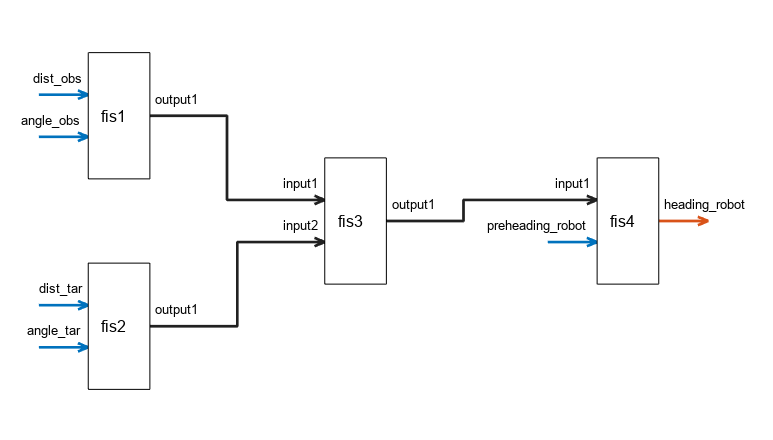
This example shows the construction of a parallel FIS tree. For more information on the types of fuzzy tree structures, see FIS Trees.
Create fuzzy systems fis1, fis2, and fis3, each with two inputs and one output.
fis1 = mamfis(Name="fis1",NumInputs=2,NumOutputs=1); fis2 = mamfis(Name="fis2",NumInputs=2,NumOutputs=1);
Create the FIS tree such that the FIS objects are in parallel; that is, the tree contains no interconnections and all the FIS outputs are FIS tree outputs.
parTree = fistree([fis1 fis2],[]);
Visualize the tree.
plotfis(parTree)

Evaluate the FIS tree.
output = evalfis(parTree,[0.1 0.3 0.8 0.4]);
Generate the final output by summing the FIS tree outputs.
finalOutput = sum(output);
Version History
Introduced in R2019aWhen you change the following names within a FIS tree object, the FIS tree connections now automatically update to use the new names.
Name of a component FIS object
Name of an input or output variable within a component FIS object
Previously, any connections containing the modified FIS or variable name were deleted from the FIS tree. You would then have to add the deleted connections back into the FIS tree.
To distinguish between FIS trees, you can now specify names for fistree
objects using the new Name property.
See Also
mamfis | sugfis | mamfistype2 | sugfistype2 | tunefis
MATLAB Command
You clicked a link that corresponds to this MATLAB command:
Run the command by entering it in the MATLAB Command Window. Web browsers do not support MATLAB commands.
Select a Web Site
Choose a web site to get translated content where available and see local events and offers. Based on your location, we recommend that you select: .
You can also select a web site from the following list
How to Get Best Site Performance
Select the China site (in Chinese or English) for best site performance. Other MathWorks country sites are not optimized for visits from your location.
Americas
- América Latina (Español)
- Canada (English)
- United States (English)
Europe
- Belgium (English)
- Denmark (English)
- Deutschland (Deutsch)
- España (Español)
- Finland (English)
- France (Français)
- Ireland (English)
- Italia (Italiano)
- Luxembourg (English)
- Netherlands (English)
- Norway (English)
- Österreich (Deutsch)
- Portugal (English)
- Sweden (English)
- Switzerland
- United Kingdom (English)